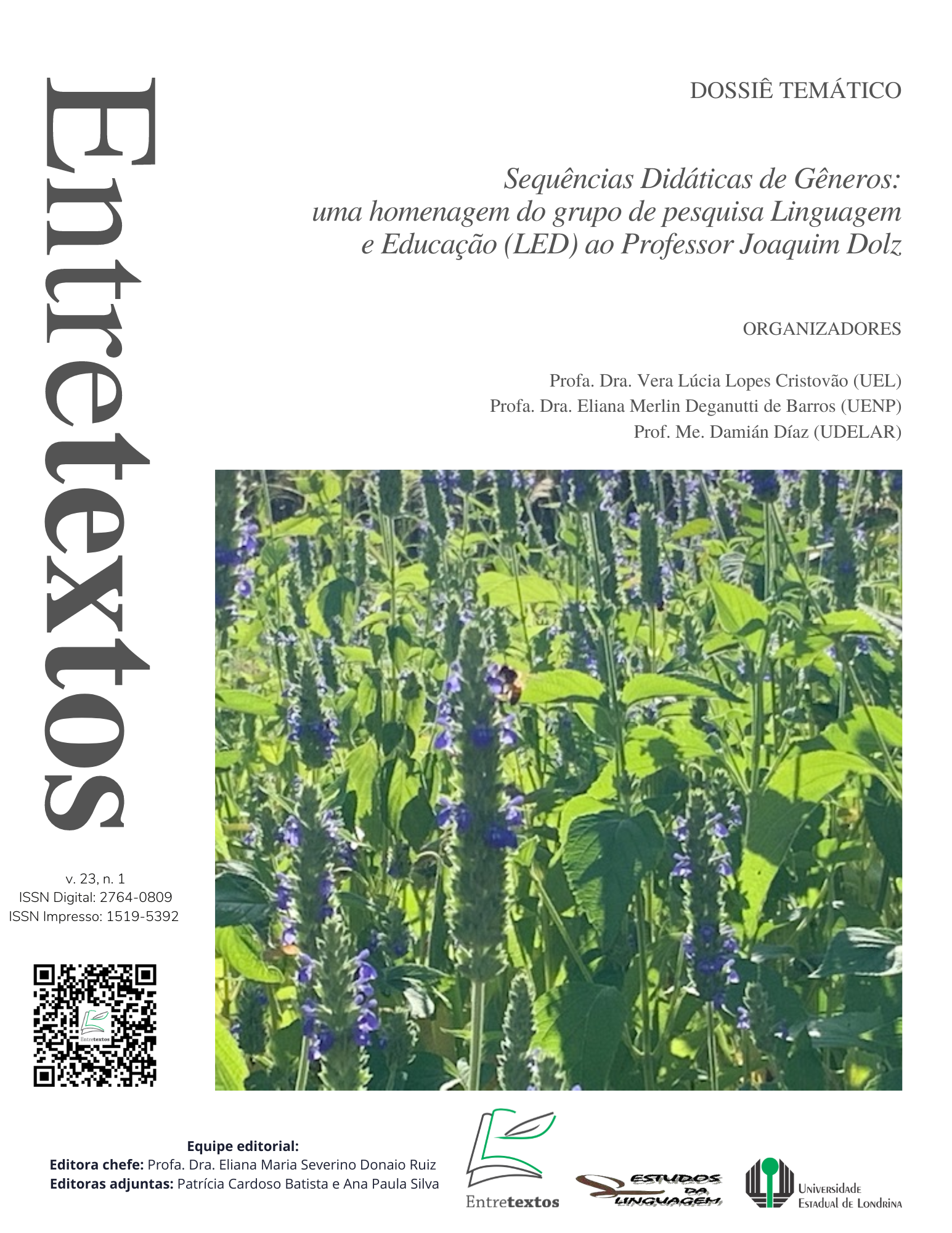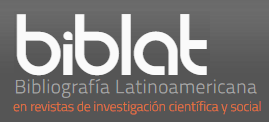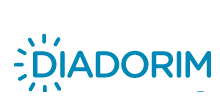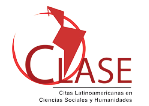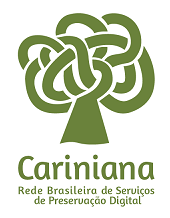Didactic sequence of the complaint letter genre
DOI:
https://doi.org/10.5433/1519-5392.2023v23n1Espp77-100Keywords:
Didactic sequence of genres, Didactic validation, Didactic materialAbstract
The data analyzed in this work are generated by the master's research of XX (2021), whose objective was to validate the elaboration of a didactic sequence (SDG) of the genre complaint letter elaborated by the study. In this work, the purpose is to present the analysis made from two categories selected for the validation process of the SDG in the scope of the external didactic transposition: the induction principle and the variation of the activities; these categories were deduced, in the exploratory stage of the research, from the theoretical systematization that is the basis of the SDG methodology. The theoretical contribution of this research is, consequently, the didactic aspect of the Sociodiscursive Interactionism studies, especially when it comes to language teaching through SDGs. Methodologically, the research is anchored in the field of Applied Linguistics, in the qualitative-interpretative approach of the documentary type. The results point to the importance of didactic validation in the teacher education process, even at the level of external didactic transposition, for example, the validation of the material developed for conducting the SDG before its implementation in a teaching context since it provides a metacognitive reflection process that is very important for teacher education.
Downloads
References
BARROS, Eliana Merlin Deganutti. A metodologia das sequências didáticas de gêneros sob a perspectiva do conceito interacionista de ZPD. In: BRADILEONE, Ana Paula Franco; OLIVEIRA, Vanderleia da Silva. Literatura e língua portuguesa na educação básica: ensino e mediações formativas. Campinas: Pontes, 2020. p.127-144.
BARROS, Eliana Merlin Deganutti de. Gestos de ensinar e aprender gêneros textuais: a sequência didática como instrumento de mediação. 2012. 366 f. Tese (Doutorado em Estudos da Linguagem) - Universidade Estadual de Londrina, Londrina, 2012. Disponível em: http://www.bibliotecadigital.uel.br/document/?code=vtls000171939. Acesso em: 30 nov. 2022.
BARROS, Eliana Merlin Deganutti de; CORDEIRO, Glaís Sales. A validação da metodologia das sequências didáticas de gêneros sob a perspectiva do gesto didático de ativação da memória das aprendizagens. In: BARROS, Eliana Merlin Deganutti de; CORDEIRO, Glaís Sales; GONÇALVES, Adair Vieira (org.). Gestos didáticos para ensinar a língua: agir docente e gêneros textuais. Campinas: Pontes, 2017. p. 217-249.
BRASIL, CAPES. Documento de Área - Ensino. Brasília: CAPES, 2019.
BRASIL. Ministério da Educação. Base Nacional Comum Curricular. Brasília: MEC, 2018.
BRONCKART, Jean-Paul. Restrições e liberdades textuais, inserção social e cidadania. Revista da Anpoll, v. 1, n. 19, 2005. DOI: https://doi.org/10.18309/anp.v1i19.467. Disponível em: https://revistadaanpoll.emnuvens.com.br/revista/article/view/467. Acesso em: 20 nov. 2022.
BRONCKART, Jean-Paul. Atividade de linguagem, textos e discursos: por um interacionismo sócio-discursivo. Trad. Anna Rachel Machado e Péricles Cunha. 2. reimpressão. São Paulo: EDUC, 2003.
CHEVALLARD, Yves. On didactic transposition theory: some introductory notes. 1989. Disponível em: <http://yves.chevallard.free.fr/spip/spip/rubrique.php3?id_rubrique=6>. Acesso em: 17 nov. 2022.
XX, 2021
XX; XX, 2021
DE PIETRO, Jean-François; SCHNEUWLY, Bernard. O modelo didático do gênero: um conceito da engenharia didática. In: NASCIMENTO, Elvira Lopes (org.). Gêneros textuais: da didática das línguas aos objetos de ensino. 2. ed. Campinas: Pontes Editores, 2014. p. 51-81.
DOLZ, Joaquim. Entrevista com Prof. Dr. Joaquim Dolz, da Universidade de Genebra (Suíça). [S. l.]. 2020. 1 vídeo (1h31min30s). Publicado pelo canal GP DIALE Diálogos Linguísticos e Ensino. Disponível em: https://www.youtube.com/watch?v=lGulajUf1Ok. Acesso em: 05 set. 2022.
DOLZ, Joaquim. Claves para enseñar a escribir. LEER.ES, 2009. Disponível em: http://leer.es/recursos/escribir/detalle//asset_publisher/3fAFCQK7mwkO/content/claves-para-ensenar-a-escribir-joaquim-dolz. Acesso em: 18 nov. 2022.
DOLZ et al. Chapitre 3: Méthodologie. In: DOLZ, Joaquim; GAGNON, Roxane. Former à enseigner la production écrite. Les Villeneuve d'Ascq - France: Presses universitaires du Septentrion, 2018. p. 117-138.
DOLZ, Joaquim; GAGNON, Roxne; DECÂNDIO, Fabrício. Uma disciplina emergente: a Didática das Línguas. In: NASCIMENTO, Elvira Lopes (org.). Gêneros textuais: da didática das línguas aos objetos de ensino. 2. ed. Campinas: Pontes Editores, 2014. p. 21-50.
DOLZ, Joaquim; NOVERRAZ, Michele; SCHNEUWLY, Bernard. Sequência Didática para o oral e a escrita: apresentação de um procedimento. In: SCHNEUWLY, Bernard; DOLZ, Joaquim (org.). Gêneros orais e escritos na escola. Trad. Roxane Rojo e Glaís Sales Cordeiro. São Paulo: Mercado das Letras, 2004, p. 95-128.
FLICK, Uwe. Desenho da pesquisa qualitativa. Trad. Roberto C. Costa. Porto Alegre: Artmed, 2009.
GIL, Antonio Carlos. Métodos e técnicas de pesquisa social. 6. ed. São Paulo: Atlas, 2014.
MOREIRA, Marco Antônio. A teoria da mediação de Vygotski. In: MOREIRA, Marco Antônio. Teorias de aprendizagem. 2.ed. São Paulo: E.P.U, 2015, p.107-120.
PASQUIER, Auguste; DOLZ, Joaquim. Um decálogo para ensinar a escrever. Tradução de Roxane Helena Rodrigues Rojo. Cultura y Educación, Madrid, n. 2, p.1-9. 1996. Disponível em: https://www.escrevendoofuturo.org.br/arquivos/4928/um-decalogo-dolz-pasquier.pdf. Acesso em: 20 nov. 2022.
SCHNEUWLY, Bernard; DOLZ, Joaquim (org.). Gêneros orais e escritos na escola. Trad. Roxane Rojo e Glaís Sales Cordeiro. São Paulo: Mercado das Letras, 2004.
VIGOTSKI, Lev Semenovich. Pensamento e Linguagem. Trad. Jefferson L. Camargo. 4. ed. São Paulo: Martins Fontes, 2008.
Downloads
Published
How to Cite
Issue
Section
License
Copyright (c) 2023 Eliana Merlin Deganutti Barros, Samandra de Andrade Corrêa

This work is licensed under a Creative Commons Attribution 4.0 International License.
Entretextos adota a Licença Creative Commons Attribution 4.0 International, portanto, os direitos autorais relativos aos artigos publicados são do/s autor/es.
Sob essa licença é possível: Compartilhar - copiar e redistribuir o material em qualquer suporte ou formato. Adaptar - remixar, transformar, e criar a partir do material, atribuindo o devido crédito e prover um link para a licença e indicar se mudanças foram feitas.

